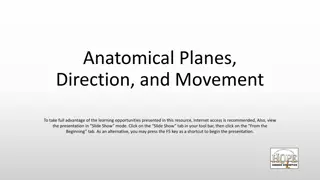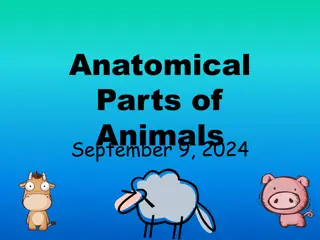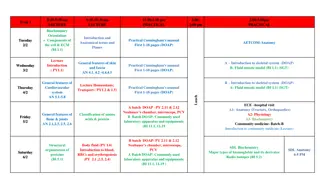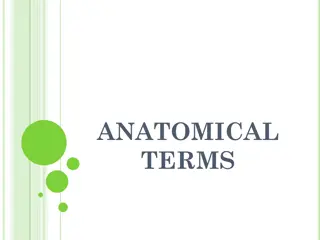Anatomy of the Kidney: Essential Features and Functions
The kidneys play a vital role in filtering waste products, regulating electrolyte balance, maintaining blood pH, producing hormones, and more. This article explores the anatomical features of the kidneys, including their position, extent, internal structure, vascular segments, and coverings. It also
0 views • 16 slides
Understanding the General Characteristics of Gymnosperms
Gymnosperms, originating in the Paleozoic era, were dominant in the Jurassic and Cretaceous periods. With naked seeds and xerophytic traits, these plants exhibit unique features such as heterospory, symbiotic root associations, and different leaf types. Examples include Cycus, Pinus, and Gnetum. The
5 views • 41 slides
Radiographic Imaging Methods of the Respiratory System
Radiographic imaging plays a crucial role in the evaluation and diagnosis of thoraco-mediastino-pleuro-pulmonary conditions. Techniques like radioscopy, digital radiography, computer tomography, magnetic resonance imaging, conventional pulmonary angiography, and hybrid imaging methods offer detailed
10 views • 21 slides
Understanding Heightmap Segmentation in DICOM Imaging
Exploring the use of heightmaps in DICOM imaging for surface identification in 3D volumes and retinal layer surfaces in ophthalmic tomography. Learn about segmentation tasks, binary segmentation results, and the role of heightmaps in classifying anatomical features in medical images. Discover how se
1 views • 28 slides
Understanding Otitis Media: Causes, Symptoms & Treatment
Otitis media is middle ear inflammation commonly affecting children. Peak incidence is between 6-12 months, with bacterial and viral causes. Risk factors include immune suppression, family history of OM, and anatomical abnormalities. Types include acute, with effusion, and chronic suppurative otitis
0 views • 12 slides
Understanding the Urinary System: Anatomical Structures and Terms
This informative content delves into the anatomical structures and terms related to the urinary system, covering key components such as the kidneys, ureters, bladder, and urethra. It explains important terms like renal pyramids, calices, and ureter dexter/sinister, providing a comprehensive overview
1 views • 8 slides
Maintaining an Operating Table: Principles and Functions
An operating table system comprises three components - the table column, table top, and transporter, each available in different versions for various surgical disciplines. Stationary tables are anchored to the floor, offering flexibility to adapt to patient needs. Mobile tables provide maneuverabili
0 views • 12 slides
Economic Aspects of Applied Plant Anatomy in Practical Use
Applied Plant Anatomy involves the practical application of anatomical knowledge in various fields such as identification, classification, taxonomic applications, medicinal plants, food safety, wood analysis, forensic investigations, and more. By understanding plant anatomy, professionals can utiliz
0 views • 26 slides
Overview of Paramphistomidae in Veterinary Helminthology at Bihar Animal Sciences University
This content delves into Paramphistomidae, focusing on species, final hosts, intermediate hosts, and anatomical characteristics such as lobed testes and suckers. The text describes common species like Paramphistomum cervi and Paramphistomum sp., detailing their physical attributes and distinguishing
0 views • 25 slides
Understanding the Anatomy of Tibia - A Comprehensive Overview
The presentation focuses on the detailed study of the tibia, covering its features, functions, and anatomical aspects. It includes information on the parts, surfaces, and attachments of the tibia, as well as its relation to surrounding structures in the leg. Learning objectives and images aid in bet
0 views • 25 slides
Understanding the Anatomy of the Cerebellum: External and Internal Features
Explore the intricate details of the cerebellum with Prof. Ahmed Fathalla Ibrahim. Learn about the external features, anatomical subdivisions, internal structure, and nuclei of the cerebellum. Understand its origin, position in the brainstem, and connections to the brainstem. Gain insights into the
1 views • 26 slides
Otitis Externa: Overview, Risk Factors, and Treatment
Otitis externa, also known as swimmer's ear, is an inflammation of the external auditory canal. It can be acute or chronic and is common among individuals aged 7-14 years. The main causative organisms include Pseudomonas aeruginosa and Staphylococcus aureus. Risk factors include swimming in pools, h
0 views • 10 slides
Understanding the Anatomy of the Small Intestine: Duodenum, Jejunum, and Ilium
The small intestine is a vital part of the digestive system, comprising the duodenum, jejunum, and ileum. The duodenum, the fixed part, has specific anatomical features and relations with adjacent structures. Understanding the different parts of the duodenum, including their location and relationshi
0 views • 16 slides
Understanding Anatomical Directions and Movements in Sports Medicine
Anatomical directions play a crucial role in explaining the precise location of body structures in relation to each other. They are utilized regardless of the actual position of the body, with terms like superior, inferior, anterior, posterior, medial, lateral, proximal, and distal aiding in clear c
0 views • 38 slides
Understanding Anatomical Planes, Directions, and Movement in Human Body
Explore the fundamentals of anatomical planes, direction, and movement in the human body. Learn about the three cardinal planes of motion, anatomical positions, directions, and their significance in describing body structures and movements. Gain insights into the anatomical position and how it relat
1 views • 35 slides
Anatomical Parts of Different Animals Visual Guide
Explore the detailed anatomical parts of various animals like dairy cow, hog, sheep, and more through informative images. Learn about the different body regions and components such as neck, rump, shoulder, hoof, and more.
0 views • 7 slides
Vertebrates Final Review - Study Guide with Images
Explore the world of vertebrates with this comprehensive final review. Learn about chordates, fish, amphibians, reptiles, birds, and mammals through informative images and questions. Test your knowledge on topics like excretion, respiratory organs, locomotion, and anatomical features unique to chord
0 views • 74 slides
Anatomy of GI Rectum and Anal Canal: A Detailed Visual Guide
This visual guide showcases detailed images of the gastrointestinal (GI) rectum and anal canal anatomy, including structures such as the perineum, pelvic diaphragm, external and internal anal sphincters, and various junctions within the rectum. Each image provides a clear depiction of the anatomical
0 views • 6 slides
Modernizing Organ Donation Laws: The Uniform Anatomical Gift Act of 2006
The Uniform Anatomical Gift Act (UAGA) of 2006 aims to enhance the donation process by introducing new definitions, emphasizing personal autonomy, and providing clearer rules. It addresses the need for uniformity, updates to reflect current practices, and modernizes the Act to ensure a smoother orga
0 views • 14 slides
Biochemistry Orientation, Cell Components, Anatomical Terms, and Practical Sessions Week 1
Delve into the world of Biochemistry with an orientation on cell components and the Extracellular Matrix (ECM). Explore anatomical terms and planes, setting the foundation for further learning. Engage in practical sessions using Cunningham's manual for hands-on experience in the field. Week 1 is pac
0 views • 38 slides
Pre-Lecture Material for Gross Anatomy: TBS and Anatomical Planes
Understand the Typical Body Segment (TBS) concept, a transverse section through the human body, and the importance of anatomical planes for orienting and dividing the body into sagittal, coronal, and transverse sections. Prepare effectively for Gross Anatomy lectures by grasping these foundational c
0 views • 6 slides
Understanding the Mediastinum: Boundaries, Divisions, and Contents
The mediastinum is a critical anatomical region in the thoracic cavity that houses various structures like the heart, thoracic vertebrae, diaphragm, and sternum. Divided into superior and inferior sections, it contains essential organs, vessels, nerves, and lymph nodes. Understanding its boundaries,
0 views • 25 slides
Fetal Pig Dissection Lab: Observing External Features and Respiratory System
In this detailed lab report on fetal pig dissection, students are tasked with observing the external features of the pig, determining its gender, examining teeth and skin, and studying the importance of the umbilical cord. The lab also delves into the respiratory system, focusing on cartilage rings,
0 views • 24 slides
Anatomical Terminology Evolution: From Latin to Modern Standards
Anatomical terms have evolved over centuries into a unified nomenclature system known as Nomina anatomica. This system, initially based on Latin and Greek words, faced confusion and disagreement among anatomists, leading to revisions and the introduction of modern anatomical terminology. The structu
0 views • 27 slides
Essential Joint Motions and Anatomical Directions Explained
Explore various types of joint motions such as abduction, flexion, rotation, and more, along with anatomical directions like anterior, posterior, superior, and inferior. Understand the body's movements and positions with detailed illustrations in the anatomical context.
0 views • 10 slides
Fascial Compartments and Anatomy of Leg and Foot
Understanding the fascial compartments and anatomy of the leg and foot is essential for medical students. This lecture by Dr. Jamila El Medany and Dr. Saeed Vohra covers the deep fascia of the leg, fascial compartments, muscles, blood supply, and nerve supply of the anterior compartment, as well as
0 views • 19 slides
Understanding Juvenile Hallux Valgus: Diagnosis and Management Insights
Delve into the world of juvenile hallux valgus, a condition affecting the alignment of the big toe in children. Learn about its different forms based on age groups, associated anatomical features, pathoanatomy, soft tissue, and bony deformities. Discover the hereditary and syndromic links, diagnosti
0 views • 45 slides
Detailed Study of Rat's Systematic Position, Habitat, and External Morphology
Dive into the world of rats with a comprehensive exploration of their systematic position in the animal kingdom, nocturnal habits, burrow-dwelling behavior, and external morphology. Learn about the rat's reproductive patterns, average lifespan, and distinctive anatomical features from head to tail.
0 views • 8 slides
Comparative Anatomy of Horse and Human Bones at Whispering Oak Stables
Explore the detailed comparison of horse and human bones, highlighting the similarities and differences in their structure and function. From forelimbs to hind legs, discover homologous structures and learn how these anatomical features serve unique purposes in each species.
0 views • 11 slides
Roman Civilization Overview
Roman civilization was influenced by Greek culture, as seen in their art, literature, and architecture. Roman artists and writers borrowed ideas from the Greeks but adapted them to suit their needs. They created realistic statues, innovative buildings with features like arches and domes, and iconic
0 views • 36 slides
Characteristics of Mandibular Incisors in Permanent Dentition
Mandibular incisors in the permanent dentition are unique with 2 centrals and 2 laterals, featuring smaller dimensions and specific anatomical characteristics such as incisal ridge inclinations, lingual surface smoothness, root grooves, and distinct crown outlines. The morphology of these teeth diff
0 views • 13 slides
Respiratory Tract Anatomy Overview
The respiratory tract anatomy includes various structures like mucosa, submucosa, and adventitia in the trachea, bronchi, bronchioles, and terminal bronchioles. Each component has specific compositions and functions, ranging from respiratory epithelium to smooth muscle layers. The images provide a v
0 views • 15 slides
Understanding the Anatomy and Histology of the Conjunctiva
This educational content explores the intricate details of the conjunctiva, a thin mucous membrane that lines the inner surface of the eyelids and globe. Topics include anatomical divisions, histological features such as epithelium and stroma, and common microbial conjunctival pathologies like bacte
0 views • 51 slides
Understanding the Orbital Region: An Overview
The orbital region encompasses the orbits, eyelids, ciliary and tarsal glands, and anatomical borders. It consists of bony cavities protecting the eyeballs, eyelids that shield the eyes, and intricate structures like the lacrimal apparatus and muscles. Understanding the components and anatomical rel
0 views • 15 slides
Understanding Cortisol and Cushing's Syndrome: Biochemical Insights
This content delves into the physiological and biochemical aspects of cortisol, diagnostic algorithms for Cushing's syndrome, and the interpretation of laboratory and radiological investigations for diagnosis. Explore the adrenal gland's anatomical features, the HPA axis, and glucocorticoid function
0 views • 16 slides
Introduction to Anatomy: Anatomical Terms and Skeletal System
An introduction to anatomy covering anatomical terms and the skeletal system. It defines anatomy, explains anatomical sciences, discusses the skeletal system, and outlines anatomical terminology including terms of position. The content includes objectives, classifications of bones, and different ana
0 views • 28 slides
Understanding Anatomical Terminology: Prefixes, Suffixes, and Roots
Explore the fundamentals of anatomical terminology by delving into prefixes, suffixes, and roots. Learn how these components modify and define medical terms, with examples and visuals to aid comprehension.
0 views • 12 slides
Salient Characters and General Features of Phylum Acanthocephala
Discover the salient characters and general features of Phylum Acanthocephala, a group of parasitic organisms with unique anatomical characteristics. Explore the body structure, presence of a retractable proboscis, absence of body segmentation and alimentary canal, as well as the lack of certain org
0 views • 10 slides
Anatomical Terminology Practice Exam: Body Regions and Landmarks
Test your knowledge of anatomical terminology by identifying various body regions and landmarks in this interactive practice exam. Practice naming cranial, cervical, thoracic, pubic, pectoral, axillary, brachial, and antecubital regions with the help of visual aids. Improve your understanding of ana
0 views • 32 slides
Understanding the Anatomy of the Hand and Wrist
Explore the bones, articulations, and structures of the hand and wrist, including carpal bones, flexor and extensor retinaculum, and carpal tunnel. Learn about the anatomical snuff box, wrist retinacula, nervous and arterial distribution, and the resting and anatomical position of the hand. Detailed
0 views • 20 slides







































